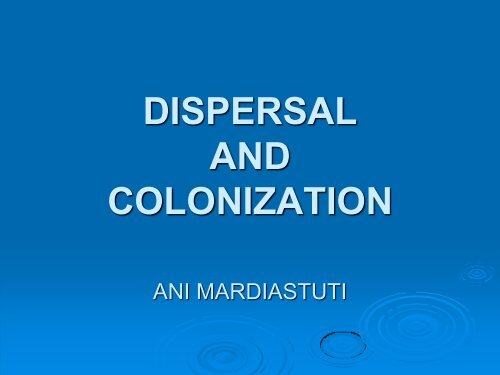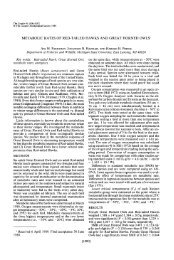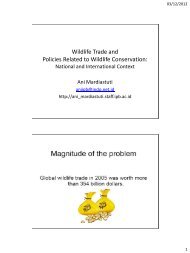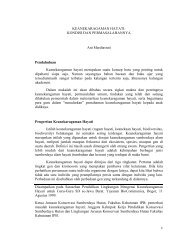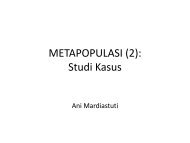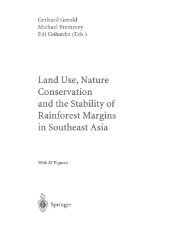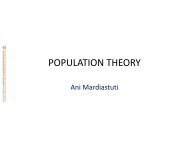Dispersal & Colonization
Dispersal & Colonization
Dispersal & Colonization
Create successful ePaper yourself
Turn your PDF publications into a flip-book with our unique Google optimized e-Paper software.
DISPERSAL<br />
AND<br />
COLONIZATION<br />
ANI MARDIASTUTI
<strong>Dispersal</strong><br />
Process whereby an organism is able to<br />
spread from its plate of original to<br />
another locality
<strong>Dispersal</strong> → hinders by<br />
environmental factors → barriers
Barriers<br />
Physical Barriers<br />
☻<br />
☻<br />
☻<br />
Water<br />
Topography (Mountain, Cliffs, valley)<br />
Desert<br />
Ecological Barriers<br />
☻<br />
☻<br />
☻<br />
☻<br />
Climate zones<br />
Living environment<br />
Cultural desert<br />
Ecological “desert” (Salinity, Soil type, etc)
Active<br />
(by the organism)<br />
<strong>Dispersal</strong><br />
Passive<br />
(by a carrier)
Active <strong>Dispersal</strong><br />
Plants → seeds, spores<br />
Animal → organs and modes of<br />
locomotion
Passive <strong>Dispersal</strong><br />
Anemochore dispersal<br />
(wind and air current)<br />
Hydrochore dispersal (water)<br />
Anemohydrochore dispersal<br />
Biochore dispersal (other organism)<br />
Anthropochore dispersal (by human)
Anemochore <strong>Dispersal</strong><br />
By air<br />
Airborne
Hydrochore <strong>Dispersal</strong><br />
Rafting<br />
Eaten by birds
Anemohydrochore <strong>Dispersal</strong>
Biochore <strong>Dispersal</strong><br />
Burung merpati<br />
Burung laut
Anthropochore<br />
<strong>Dispersal</strong><br />
Unintention
Anthropochore <strong>Dispersal</strong> by Intention
<strong>Dispersal</strong> Route
<strong>Dispersal</strong><br />
Route<br />
Sweepstaker
<strong>Dispersal</strong> Route Lard Bridge
<strong>Colonization</strong><br />
A process of setting down by an organism in<br />
a new habitat
Good Colonizers<br />
<br />
<br />
<br />
<br />
Able to with stand extreme<br />
condition ( Of food and water)<br />
Good ability to reproduce good<br />
Good competitor, if necessary<br />
“pioneer” species
<strong>Dispersal</strong><br />
<strong>Colonization</strong><br />
Existence
<strong>Colonization</strong> of Krakatau<br />
(Erupted in 1883)
<strong>Colonization</strong> of Krakatau<br />
(40 years)
<strong>Colonization</strong> of Krakatau<br />
(100 years)
DISPERSAL AND COLONIZATION<br />
Island<br />
1. Start with<br />
one continuous<br />
population.<br />
Then, a colonist<br />
floats to an<br />
island on a raft.<br />
Why would these<br />
populations<br />
diverge into<br />
separate<br />
populations<br />
Continent<br />
2. Finish with<br />
two populations<br />
isolated from<br />
one another.
DISPERSAL AND COLONIZATION<br />
Continent<br />
Island<br />
1. Start with<br />
one continuous<br />
population.<br />
Then, a colonist<br />
floats to an<br />
island on a raft.<br />
2. Finish with<br />
two populations<br />
isolated from<br />
one another.<br />
- genetic drift -<br />
colonists are few and<br />
likely to be nonrandom<br />
sample of<br />
original population<br />
- natural selection -<br />
selection pressures in<br />
new environment are<br />
unlikely to be the<br />
same as in old<br />
environment<br />
- leads to different<br />
species on islands vs.<br />
mainland


